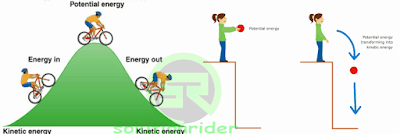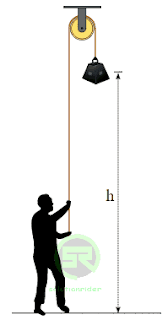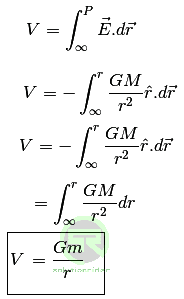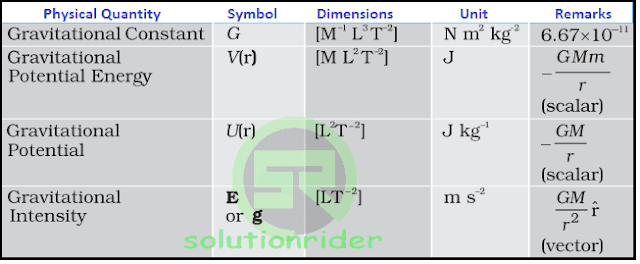Topics Covered
1) Gravitational potential energy.
2) Escape velocity.
3) Orbital velocity of a satellite.
4) Geostationary satellites.
Gravitational Potential Energy:
All conservative forces have potential energy associated with them. The force of gravity is a conservative force and we can calculate the potential energy of a body arising out of this force, called the gravitational potential energy. It represents the potential an object has to do work as a result of being located at a particular position in a gravitational field.
Consider an object of mass “m” which is lifted through a height “h” against the force of gravity with the help of a pulley and a rope, as shown below:
The force due to lifting the box and the force due to gravity will act parallel to each other. If “g” is the magnitude of the gravitational acceleration, we can find the work done by the force on the weight, as here:
Gravitational Potential Energy = Fg × height = (m×g)×h = mgh
Here, Fg is the force of gravity, g is the acceleration due to gravity and m is the mass of the object.
If we now calculate the work done in lifting a particle from r = r1 to r = r2 provided (r2> r1) along a vertical path, we get instead.
Here, Fg is the force of gravity, g is the acceleration due to gravity and m is the mass of the object.
If we now calculate the work done in lifting a particle from r = r1 to r = r2 provided (r2> r1) along a vertical path, we get instead.
Gravitational Potential:
The gravitational at any point may be defined as the potential energy per unit mass of a test mass placed at that point, V = U/m (where U is the gravitational potential energy of the test mass m).
Thus, if the reference point is taken at an infinite distance, the potential at a point in the gravitational field is equal to the amount of work done by the external agent per unit mass in bringing a test mass from infinite distance to that point. The expression for the potential is given by:
Escape Velocity:
Escape velocity on the surface of the earth is the minimum velocity given to a body to make it free from the gravitational field, i.e. it can reach an infinite distance from the earth.
Let ve be the escape velocity of the body on the surface of the earth and the mass of the body to be projected be m. Now, applying conservation of energy:
1/2 mve2 – GMm/R = 0
⇒ ve = √(2GM/R) or ve = √2gR = √gD
Where, R is the radius and D is the diameter of the earth respectively.
Orbital Velocity:
It is the velocity at which a body revolves around the other body. Objects that travel in uniform circular motion around the Earth are called to be in orbit. The velocity of this orbit depends on the distance between the object and the center of the earth.This velocity is usually given to the artificial satellites so that it revolves around any particular planet.
The orbital velocity formula is given by, v = √GM/r
Geo-stationary and Polar satellites:
A satellite is an object that orbits a larger object in space. Example: Moon is the Earth’s natural satellite. Artificial satellites in orbit around the Earth have different orbits. Satellites in lower orbits travel faster than those in higher orbits.
A geostationary satellite is an earth-orbiting satellite, placed at an altitude of approximately 35,800 kilometers (22,300 miles) directly over the equator, that revolves in the same direction the earth rotates (west to east).
Important Points :
| 1) If the force of gravity is removed then, the object would fall back down to the ground and the gravitational potential energy would be transferred to kinetic energy of the falling object. 2) Gravitational potential energy (U):- (a) Two particles: U = -Gm1m2/r (b) Three particles: U = –Gm1m2/r12 – Gm1m3/r13 – Gm2m3/r23. The work done in moving the particle is just the difference of potential energy between its final and initial positions. 3) Escape velocity (ve) in terms of earth’s density:- ve = R√(8πGρ/3) 4) If a satellite of mass m revolves in a circular orbit around the earth of radius R and h be the height of the satellite above the surface of the earth, then, r = R+h. So, orbital velocity, v = √(MG/R+h) = R√(g/R+h) 5) In case the satellite is orbiting very close to the surface of the earth, then orbital velocity will be,v = √gR 6) The relation between escape velocity ve and orbital velocity v:- v= ve/√2 (if h<<R) 7) The higher the orbit of a satellite, the longer its ‘period’ (time to make one orbit). |
The following table summarizes the dimension of the quantities involved:







